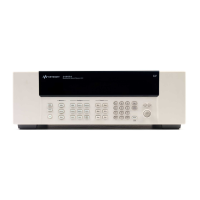326 34980A User’s Guide
13 Breadboard Module
Programming the 34959A Breadboard Module
The 34959A Breadboard Module has three methods of signal input/output
between the 34980A mainframe and the user-designed circuitry. The first
is to access the four Analog Buses. The second provides control for up to
32 general purpose relays you may install on your PC board (only 28
general purpose relays if the four Analog Bus relay control lines will be
used). The third provides two bytes of simple digital I/O with handshake
signals.
Analog Bus Relay Functions
The 34980A mainframe provides four two- wire internal Analog Buses for
signal routing. The channels for the four Analog Buses are numbered 911
through 914. If any of the optional Analog Bus relays K101 through K104
are installed on the 34959A, you can route external signals to the Analog
Buses or access signals introduced to those buses through other installed
modules. Refer to Chapter 2 for configuring the internal DMM for making
voltage, current, resistance, temperature or frequency measurements.
The Agilent 34980A Programmer’s Reference details the SCPI language
and syntax for all commands available through the remote interface.
Examples of some commands you will use to control relays to the analog
bus, query relay status or assign custom labels to these channels are
described below:
The
ROUTe:OPEN command is used to open a relay. The syntax is:
ROUTe:OPEN (@<ch_list>)
Example: If the Breadboard Module is in slot 1, the following command
opens relay K101 to Analog Bus 1 (channel 911):
ROUTe:OPEN (@1911)
The ROUTe:OPEN? command is used to query the status of a relay. The
syntax is:
ROUTe:OPEN? (@<ch_list>)
Example: If the Breadboard Module is in slot 3, the following query
returns the status of relay K104 to Analog Bus 4 (channel 914). A 1 is
returned if the relay is open; a 0 is returned if the relay is closed:
ROUTe:OPEN? (@3914)
The ROUTe:CLOSe command is used to close a relay. The syntax is:
ROUTe:CLOSe (@<ch_list>)

